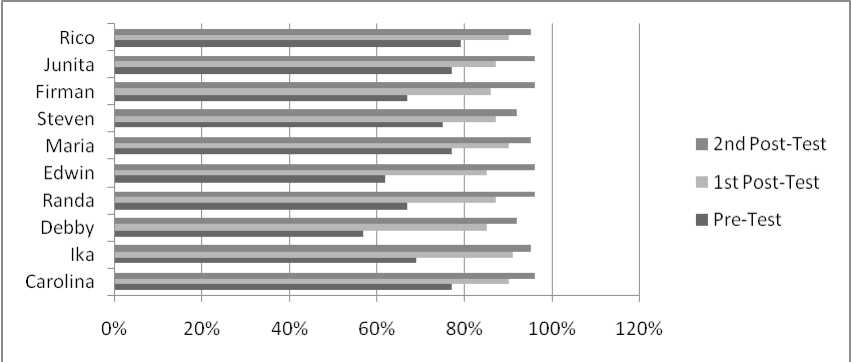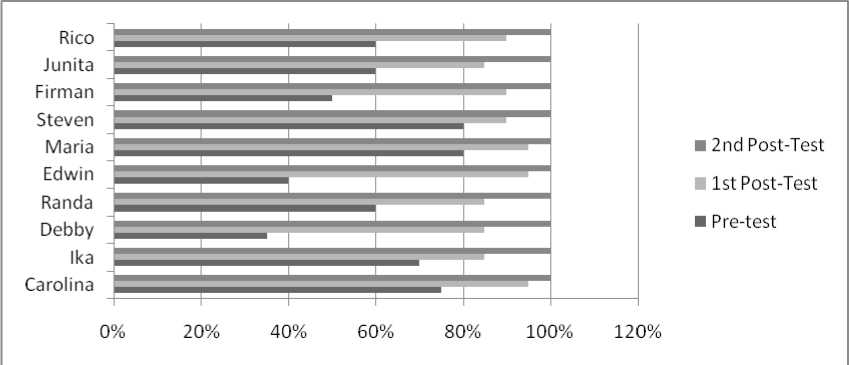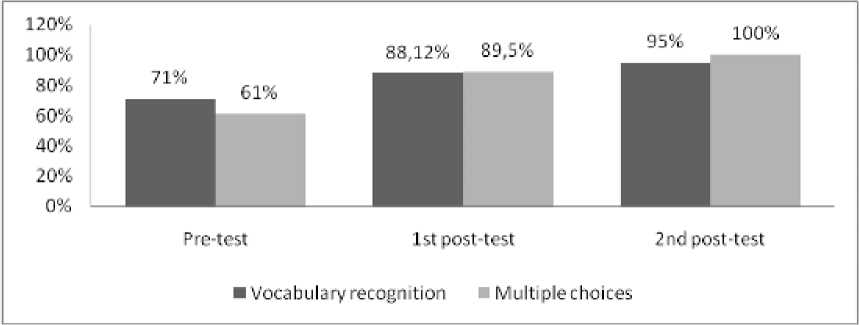LEARNING VOCABULARY USING ENGLISH MOVIE WITH SUBTITLES IN SMAK SANTO YOSEPH
on
1
LEARNING VOCABULARY USING ENGLISH MOVIE WITH SUBTITLES
IN SMAK SANTO YOSEPH
I Putu Budiana Putra
Non-Regular English Program Faculty of Letters and Culture Udayana University
Abstrak
Artikel ini berjudul “Learning Vocabulary Using English Movie with Subtitles in SMAK Santo Yoseph”. Film berbahasa inggris dapat memotivasi siswa untuk mempelajari kosa kata dan memahami bahasa inggris dengan lebih baik. Maka, berdasarkan alasan tersebut, artikel ini akan membahas bagaimana film berbahasa inggris mempengaruhi kemajuan siswa dalam mempelajari kosa kata bahasa Inggris.
Data untuk penelitian ini diperoleh dari hasil beberapa kali tes yang dikerjakan oleh 10 siswa kelas 12, SMAK Santo Yoseph Denpasar. Para siswa diberikan tes untuk mengetahui bagaimana perkembangan siswa dalam memperoleh kosa kata baru dalam bahasa inggris setelah mereka menonton film dengan menggunakan teks terjemahan. Data pada penelitian ini dianalisa dengan metode kuantitatif dan kualitatif.
Hasil dari penelitian menunjukan bahwa film berbahasa inggris yang menggunakan teks memiliki efek dalam pemahaman kosa kata apabila ditonton lebih dari satu kali. Menonton film berbahasa Inggris lebih dari satu kali dapat membantu siswa untuk mengenali kosa kata baru, dan juga dapat mempelajari ungkapan-ungkapan baru dalam bahasa Inggris. Selain itu, menonton film bergahasa Inggris dengan mengunakan teks juga dapat meningkatkan kemampuan siswa, seperti kemampuan membaca, mengengar, dan juga berbicara atau penngucapan dalam bahasa Inggris.
Menonton film berbahasa Inggris dengan bantuan teks membantu siswa SMAK Santo Yoseph untuk memahami bahasa Inggris dan memperoleh kosa kata baru. Hal itu dapat terlihat dari hasil observasi yang menunjukan bahwa kamampuan siswa dalam perbendaharaan kosa kata bahasa Inggris bertambah setelah menonton film dengan bantuan teks
Kata kunci: Pembelajaran Bahasa, Film berbahasa Inggris, Pembelajaran Kosa Kata
English movies can motivate some students to learn vocabularies and understand English better. As King (2002) states “films provide more pedagogical options and are a rich resource of intrinsically motivating materials for learners”. When students are exposed to movies, they can learn some words and phrases used
in the movies and by using subtitled movies, students can learn how to pronounce many words, and also help them to acquire new vocabulary and idioms. The use of subtitled movies may be effective to improve the reading and listening comprehension, word recognition and vocabulary acquisition of students.
Watching subtitled movies may result in acquiring various types of language properties, in addition to word meanings, one may learn the situations in which these words may be used. There may also be improvement in the ability to discern separate words in the flow of spoken language, word pronunciation, and proficiency in constructing correct sentences.
How was the English ability of the students before and after watching the movie in learning English vocabulary? And how effective was the English movies with subtitles help the improvement of vocabulary of students in learning English vocabulary?
The aims of this study were to find out the ability of the students before and after watching the movie in learning English vocabulary, and also to find the effectiveness of English movies with subtitles in improving vocabulary of students in learning English.
For the method of collecting data, a direct observation by using questionnaire and test were used in this study. And for the technique of collecting data, the students were given a pre-test in order to know the participants’ ability before they watch the
movie, they were given a test of vocabulary in a form of vocabulary recognition and multiple choices tests related to the movie. After that, the students watched 20 minutes of ‘Hotel Transylvania’ with bimodal subtitling. And after watching the movies, the students were given the same tests as before related to the movies and to complete in 5 minutes. After the students completed the second tests, they watched the video again for 20 minutes but this time with standard subtitling. And after the movies played, the students were given the same tests as before related to the movies and to complete in 5 minutes. These tests had to be done to find out the improvement of English vocabulary of the students using the subtitled movies.
The data of this study were taken from 10 of the third grade students of SMAK Santo Yoseph Denpasar. They are both male and female and most of them had been learning English since elementary school. They were selected based on their ability in English and their background where all of them were using English as a second language. The instrument of the research was taken from the movie used in this study. The title of the movie is ‘Hotel Transylvania’. ‘Hotel Transylvania’ is a 2012 American 3D computer-animated comedy film produced by Sony Pictures Animation and distributed by Columbia Pictures.
The data of this study were analyzed using the quantitative method and qualitative method. The quantitative method was used since the data is presented by using tables and numbers. The qualitative method was used in order to describe the result of the data shown in the tables. After the data were collected, the data from the tests were corrected to know the result of the tests. The ways to analyze the result of the test are as follows:
-
a. The score of each students were calculated using the following formula:
Number of correct answer(s)
Means = x 100%
Number of question
-
b. The mean score of the whole students were calculated using the following formula:
The Total Score of the Students
Means =
x 100%
Total Number of the Students
Then the result of the first test was compared with the result of the second and the third test in order to know the difference of the students’ ability before and after they watched the English movies. After the data were analyzed, they were presented in the form of table consisting of the score of correct answer and score of incorrect answer. The result of the research is presented in the form of graph as well in order to know the improvement of the vocabulary made by the students.
-
5. Findings and Discussion
Graph 1. The result of vocabulary recognition tests

The graph above shows that all of the students gained an improvement in
learning vocabulary. It can be seen that every students’ graph of score increased in every test. On the pre-test, the purpose of the test was to see the ability of the students before they watched the movie. The result shows that the score of the students was in average score. All students got more than 50% correct answers.
On the 1st post-test, all students showed an improvement and could answer more than 80% of the questions. It was because on the 1st post-test, the movie was played and used bimodal subtitling (L2 audio with L2 subtitles). In this stage, the students have already knew what words used in the test, so they were aware and paid more attention to the subtitles when they watched the movie. When the word appeared on the subtitles, the students saw the visual cues of the words in the movie, so they could guess what the meaning of each word was.
On the 2nd post-test, the movie was played again and it used standard subtitling (L2 Audio with L1 subtitles) before the test get started. By using standard subtitling, the students were able to know the meaning of the words more clearly since the subtitles were using L1. It can be seen on the graph that the students showed more improvement in learning vocabulary on the 2nd pos-test.
Graph 2. The result of multiple choice tests

The graph above shows the result of the three multiple choice tests done by the students. It can be seen that in the multiple choice test, the students showed more improvement. In the pre-test, the students answered 35%-80% of the questions
correctly, and it extremely raised to 85%-90% in the 1st post-test. And in the 2nd posttest, all of the students answered all the questions correctly.
Graph 3. Mean score of the pre-test, 1st post-test and 2nd post-test

The graph above showed the vocabulary improvement of the students. The graph also showed that the mean score of the tests got higher after the students watched the movie. So it can be said that subtitled movie helped students to get new vocabulary. The mean results of the second post-test were higher than the results of the first post-test. In the first post-test, the students watched the movie with bimodal subtitling and the movie was played with L2 audio and L1 subtitles. Then, the movie was played again with standard subtitling in the second post-test. It seemed that the students were able to understand the vocabulary easier after watching the movie for the second time and by using the standard subtitling.
The Effectiveness of Subtitled Movie in Learning Vocabulary
The effectiveness of using subtitles to learn new vocabulary found in this study, the respondents of the research learned and acquired new vocabulary after they watched the movie with subtitles. Two types of subtitling, bimodal and standard subtitling, were given to the respondents, and it appeared that after watching the movie more than once and used those two different types of subtitling, the respondents gained more vocabulary effectively. Koolstra and Beentjes (1999)
claimed that students had to watch a subtitled movie with high frequency for learning vocabulary from it. Or it can be said that subtitled movies could have an effect on vocabulary recognition if the learners watched the movie more than once. Watching the movie twice or more may help students recognize new vocabulary and they may also learn new idioms and expressions. Moreover, watching subtitled movie more than once might also develop other skills of the students, such as reading or listening comprehension, and even pronunciation. Therefore, watching English movies with subtitles is actually can be an effective method to improve the English vocabulary.
Based on the result of the research in SMAK Santo Yoseph, and other evidence found in some empirical studies, there is no doubt that video technology especially subtitled movie can be a powerful teaching tool to help students learn and acquire new vocabulary. According to Baltova (1999), as the video technology changes at a galloping speed, our options today are certainly not limited to traditional video cassettes only, although they still seem to be the most practical and accessible resource in many schools. It is inevitable, of course, that more advanced technological video, such as interactive video CD, DVD, CD-ROM, Blu-Ray, and web-based multimedia courseware will become increasingly more popular aids in both inside and outside the classroom, since those technological resources allow the students to choose the subtitles.
Baltova, Iva. 1999. The Effect of Subtitled and Staged Video Input on the Learning and Retention of Content and Vocabulary in a Second Language. Ottawa, National Library of Canada
Katchen,J. The proceeding of the fifth of international symposium in English Teaching. Taipei: The Crane Publishing Company, Ltd. 1997.
King, J. 2002. Using DVD feature films in the EFL classroom. ELT Newsletter, The weekly column, Article 88. Online Available: http://www.eltnewsletter.com
Koolstra, C.M. & Beentjes, W. (1999). Children’s vocabulary acquisition in foreign language through watching subtitled television programs at home. Journal of Psycholinguistic Research,47,52-60.
Krashen, Stephen D. 1981. “The Second Language Acquisition and Second Language Learning”. California. Pergamon Press.
Nation, P. (2005). Teaching vocabulary. Asian EFL Journal, 7(3), 47-54.
Wang, H.S, Chou, C.H, Wang, Y.H, & Hsieh, C.C (2003). A preliminary study of the effect of listening comprehension, vocabulary and attitude on ESL learning in
Taiwan. Retrieved 2010 from:
http://210.240.194.114/dct/studentsPaper/110808210041eiL.pdf
Withaw, Roland. 2009. The Influence of Film and Video on the Development of English. http://www.helium.com.
Yongqi Gu, P. (2003). Vocabulary learning in second language: Person, task, context and strategies. TESL-EJ, 7(2). Retrieved October 3, 2006, from http://www-writing.berkeley.edu/ TESL-EJ/ej26/a4.html
Discussion and feedback